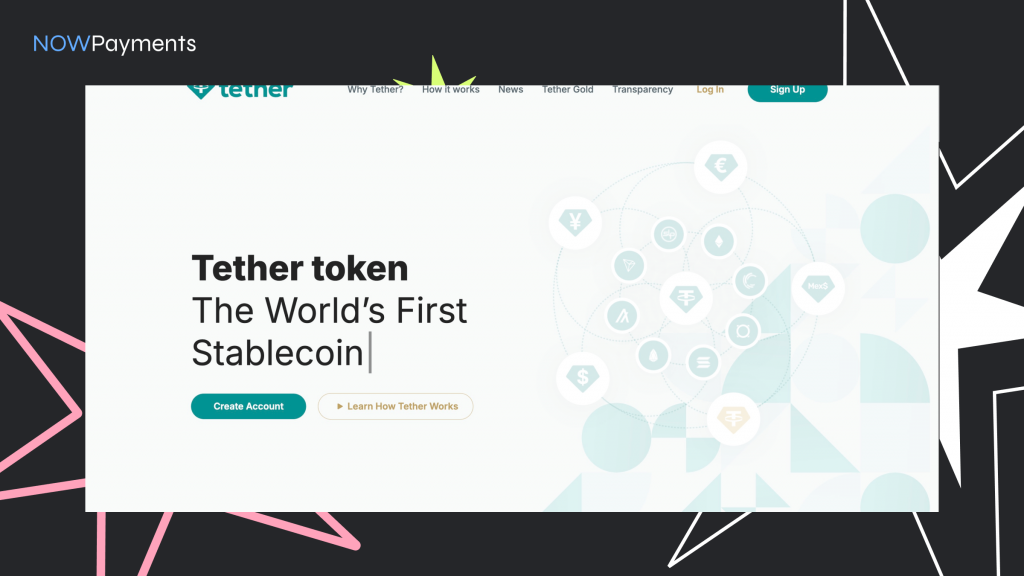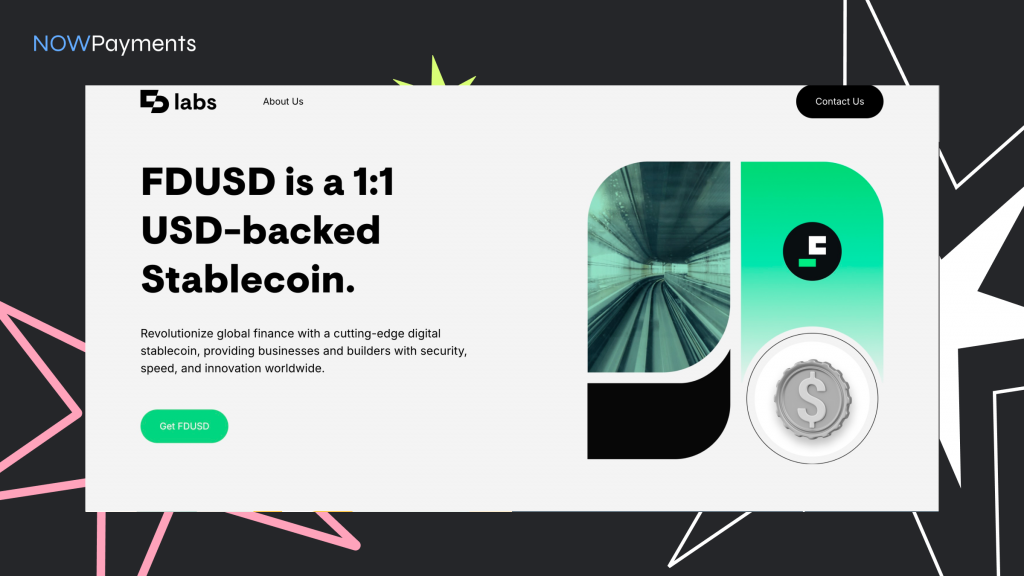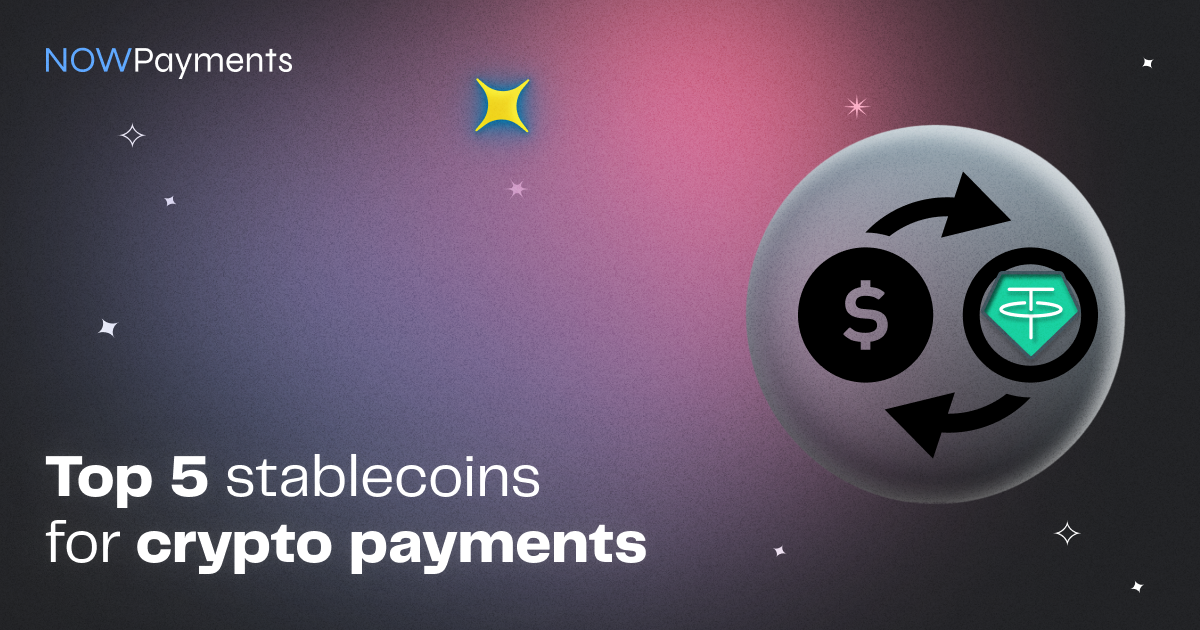Stablecoins have firmly entered the lives of business owners because they allow for a safe, cost-effective, and fast money turnover with clients and business partners. Thanks to blockchain technology, stablecoins have all the advantages inherent in cryptocurrencies, but at the same time, they remain pegged to traditional assets. This article will look at the top five stablecoins you can consider as a means of payment.
Key points:
- Stablecoins are a specific class of crypto assets that use blockchain technology to ensure security but, at the same time, are tied to the rates of major fiat currencies.
- Find the top five stablecoins and discuss their main differences and advantages.
- NOWPayments allows you to accept more than 150 cryptocurrencies for payment, including the described stablecoins.
What Are Stablecoins?
Stablecoins are a kind of cryptocurrency created to provide an efficient, reliable, and secure way to send and receive funds. The main difference between stablecoins and other digital assets is that this category of cryptocurrencies mirrors the rates of traditional fiat currencies. That is, stablecoins have high security, transparency, and cost-effectiveness thanks to blockchain technology. At the same time, they are non-volatile cryptocurrencies whose exchange rates are tied to currencies outside the crypto space. Due to this, stablecoins are ideal for accepting payments, sending funds to partners, as well as for maintaining profits during a bearish trend.
Which Stablecoins Are the Best for Payments?
Tether (USDT)

Tether is the most used stablecoin on the crypto market and occupies an honorable third place by market capitalization. This asset is issued by Tether Limited. The scheme for issuing USDT is straightforward: a user who wants to mint new USDT deposits the desired amount in fiat, and the company mints an equivalent amount in USDT. All information regarding the transparency of reserves can be found on the special page “Transparency” on the project’s official website. The main advantage of Tether as a means of payment is a tight pegging to the US dollar rate, the trust of the crypto community, as well as the high liquidity of USDT. To date, USDT operates on all leading blockchains. The most popular networks for USDT transactions are Ethereum (USDTERC-20) and Tron (USDTTRC-20). While the Ethereum network is considered the safest and most demanded network, the Tron network can be useful if you want to provide fast and cost-effective payments.
USD Coin (USDC)

USD Coin is the second most popular stablecoin, pegged to the US dollar. USDC was developed in 2018 by Circle, Coinbase, and Centre Consortium. Initially, it was clear that USD Coin is the main competitor of Tether, although it strives for transparency of absolutely all operations, increased security, and lower volatility. The developers ensure that the USDC is fully backed with real US dollars. In 2019, Grant Thornton conducted an audit of USDC reserves, as a result of which it was confirmed that the Circle issuing company fully backed its stablecoin. In addition, this token has other positive aspects: cooperation with well-known banks, including Goldman Sachs, open source code, reporting on their operations, compliance with the requirements of US regulators, and others.
First Digital USD (FDUSD)

First Digital USD (FDUSD) aim to revolutionize the digital asset landscape. Their mission is to empower users with a transformative financial instrument that combines the stability of cash reserves with the seamless efficiency of advanced blockchain technology. By offering a fully collateralized digital asset, their stablecoin ensures the utmost security, transparency, and transaction reliability. This strategic fusion of traditional stability and cutting-edge innovation allows users to confidently navigate the digital economy, unlocking a world of possibilities while maintaining the utmost trust in their financial interactions. What makes project unique? Transferable: FDUSD enables frictionless and streamlined transactions, rendering it a convenient choice for a wide range of applications and scenarios. Redeemable: FDUSD is backed by high-quality reserves- cash and cash equivalents, which enable holders the ability to redeem their FDUSD tokens for their equivalent value in US dollars. Users can trust that FDUSD is always 1:1 backed.
Dai (DAI)

Dai is the fourth largest decentralized stablecoin by market capitalization. However, it differs from the assets listed earlier. While USDT, USDC, and BUSD are backed by traditional assets, DAI is a stablecoin backed by cryptocurrencies. New DAI tokens are not issued via the mining technology, nor are they minted by a private company following its emission policy, such as Tether (USDT). Instead, any user can create a new DAI using the Maker protocol. Users generate DAI by depositing crypto assets into Maker vaults. The key advantage of DAI is that it is managed not by a private company but by a decentralized autonomous organization MakerDAO. As a result, token issuance and burning cases are managed and publicly registered using Ethereum-based smart contracts, making the entire system more transparent and less susceptible to corruption.
TrueUSD (TUSD)

TrueUSD is managed by TrustToken company. This stablecoin is a classic representative of fiat-backed stablecoins and has a tight peg to the US dollar. Nevertheless, TrueUSD has one interesting feature that allows it to gain users’ trust. Unlike the fiat-backed stablecoins mentioned above, in which the issuing company stores user funds on its bank accounts and therefore has full power over them, TrustToken locks user funds on third-party escrow accounts of trusted banks and companies. Thus, TUSD is a more decentralized asset since TrustToken does not have control over user funds. Another attractive feature is the cooperation of TrustToken and the Armanino accounting company. This company has developed a special solution using Chainlink oracles that allows you to monitor the transparency of reserves in real-time. This is a significant advantage of TUSD since attestations do not occur monthly but in real-time.
How to Accept Payments in Stablecoins?

NOWPayments is a leading crypto payment provider that allows you to accept more than 150 cryptocurrencies for payment. Our service has competitively low fees, flexibility, and reliability, and also provides various solutions that can meet the needs of any business.
- Plugins. Owners of online stores on platforms such as Magento 2, WooCommerce, PrestaShop, and others can use ready-made plugins to accept crypto payments.
- Crypto API. An easily integrated tool that allows you to accept crypto payments on any website, platform, or mobile application.
- Payment links. A customized payment link via which your customers can pay for your goods and services in a matter of clicks.
- Billing. Allows you to accept payments in stablecoins on a recurring basis (weekly/monthly/yearly).
- Point-of-Sale terminal. Business owners can implement cost-effective crypto payments directly in their brick-and-mortar stores.
To accept crypto payments using a payment link, you just need to follow a few simple steps:
- Register your NOWPayments account. Specify and verify your email address, and specify your crypto payout address.
- In the “Payment Tools” >>“Payment Link” section, click “Create payment link”.
- Fill out the form. Specify the stablecoin you want to accept for payment, the price of the item in USD, and other details.
- Copy your payment link and send it directly to consumers or post it on your website.
Conclusion
NOWPayments supports more than 150 cryptocurrencies, including the most popular stablecoins, and provides many integration tools so that everyone finds what they are looking for.

